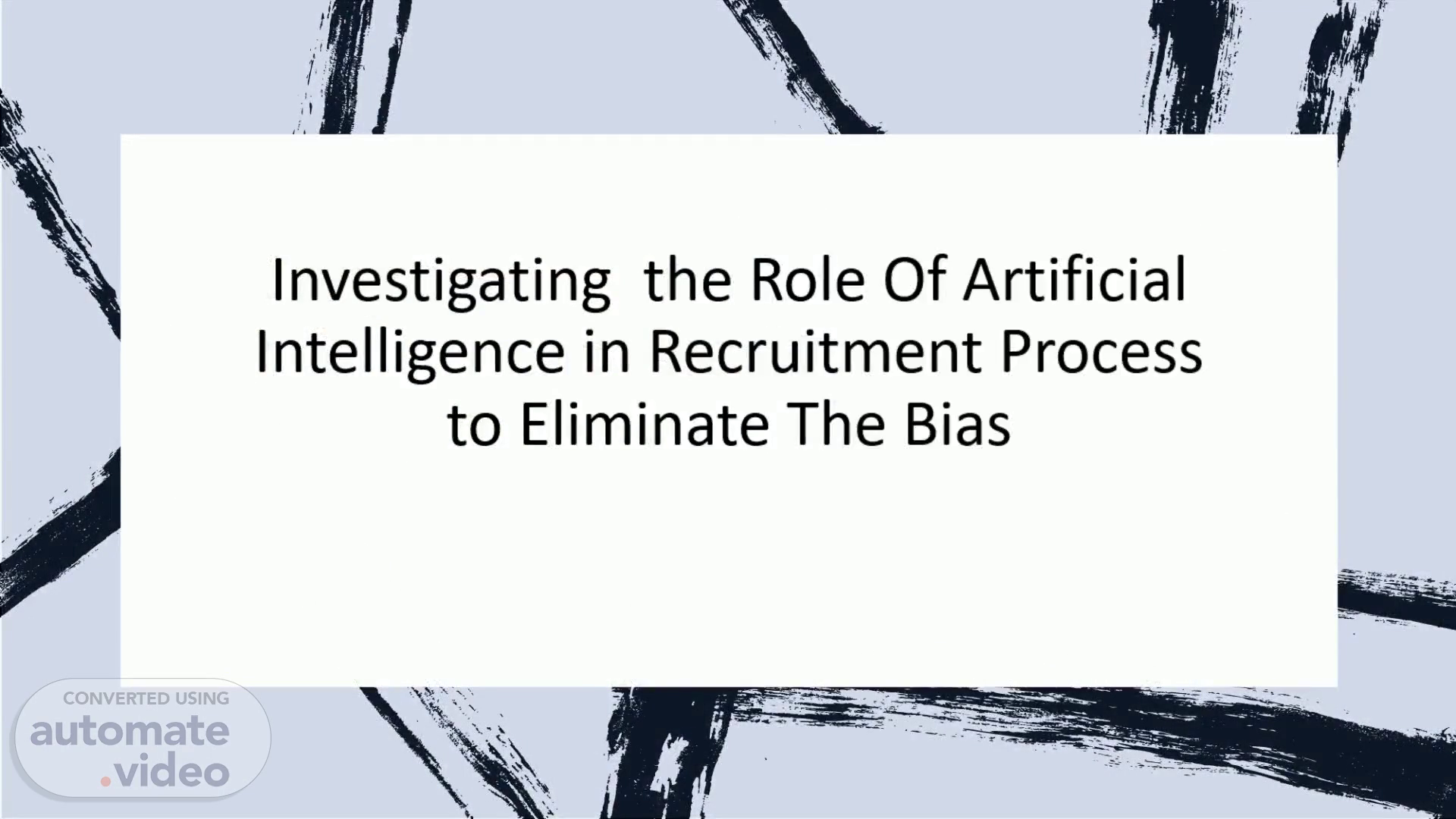
Investigating the Role Of Artificial Intelligence in Recruitment Process to Eliminate The Bias
Scene 1 (0s)
Investigating the Role Of Artificial Intelligence in Recruitment Process to Eliminate The Bias.
Scene 2 (9s)
Objective. A robot in a cafe table. Because there are so many ways artificial intelligence may be used in software development, it has been garnering increasing attention every year. Artificial intelligence (AI) is still used in contemporary computers despite being very different from human intelligence in terms of its capacity to learn, reason, and make tough decisions. Workforce recruitment is one of its possible uses, which has been sought for its capacity to assess a wide range of data and precisely estimate available possibilities..
Scene 3 (32s)
Overview. The effects of utilizing artificial intelligence in hiring, as well as the strategic shift in hiring that results from the use of AI. The consequences of utilizing AI in research are examined in the paper using a systematic review of prior work. The paper concludes that using AI to recruiting yields a high level of efficiency while also producing other benefits for candidates and businesses looking to hire new personnel. Organizations looking to streamline their employment process, especially in recruiting, should move to AI and related technology because hiring is usually a complicated process that requires a lot of resources and planning..
Scene 4 (1m 0s)
Challenges. Data sensitivity Client’s confidentially Employee engagement Human capital management Employee Benefits.
Scene 5 (1m 8s)
Importance of AI use for HR purposes. The manufacturing industries are undergoing a significant transformation due to the usage of robotics for artificial intelligence (AI). According to McKinsey's most recent projection of AI's economic impact, by 2030, AI will contribute $13 trillion to global GDP. Not to be forgotten is the HR Division. Experts in human resources today focus on combining manual and automated tasks to produce a simple, streamlined, and intuitive working environment Applications for research, technology, learning, and growth can be readily added for HR professionals..
Scene 6 (1m 34s)
Cont. –. In order to create a richer atmosphere for applicants and employees, it gives them time to grow intellectually and exhibit empathy. AI has an impact on talent management activities such as finding potential candidates, recording and maintaining the database, automating interview schedules, delivering a post, responding to job seeker inquiries, and more. It helps with routine tasks in advance. The conclusions are noteworthy, discernible, and unambiguous. It shortens the recruiting process and raises HR professionals' output. The staff has time to complete tasks that bring value, such recruitment, hiring, and procurement..
Scene 7 (2m 2s)
Approach and Methodology. 1. Responsibility and Project Intake. The employees are in charge of creating, implementing, and employing AI's capabilities while exercising reasonable degrees of judgement and care. 2. Equal and Fair. Unconscious prejudice in AI would be deliberately eliminated by the Department. 3. Traceable and Path-finders The department will set up and incorporate its AI’s capability and make sure that employees are fully informed of the technologies, creation, and operating procedures pertinent to its AI’s capability, including accessible and auditable processes, data sources, and the implementation protocols and documents..
Scene 8 (2m 30s)
Cont. –. 4. Dependable. The protection, security, and effectiveness of those capacities over their life cycles would be precisely checked and ensured for department-wide, clearly specified applications of those capacities. 5. Executing the project. The Department must increase and develop its ability to carry out its planned activities while also being able to recognize and stop unforeseen consequences, as well as disengage and deactivate deployed technologies that exhibit unintended behavior..
Scene 9 (2m 53s)
AI's Positive Effects on Organizational HRM. Various reports consider the integration of AI into HR to be realistic in any circumstance. According to a survey by Oracle/Future Workplace, many HR professionals welcome the integration of AI into their HR processes. In fact, according to a 2019 study by Oracle and Future Workplace, 64% of them said they would trust a robot more than their director for advice. HR is involved in connecting organizations with potential and present employees on a personal basis. HR departments should leverage adaptable AI technologies in order to accomplish this on a massive scale..
Scene 10 (3m 19s)
Influence of AI on HR Manager. The HR departments present a huge opportunity for AI software. Datasets with prospective employees, former applicants, and present workers all create an incredibly rich environment for artificial intelligence to produce investigation-managed knowledge into various HR-related cycles. The findings of the analysis reveal that HR departments frequently use AI-supported software to identify which employees are most likely to quit. A comprehensive analysis of many variables and AI's ability to predict outcomes may help scouts detect the deterioration of skill..
Scene 11 (3m 44s)
Conclusion. The data mentioned above make it very evident that AI presents recruiters with limitless options. The advantages range from time and money savings to improved efficiency in hiring staff with better training. Organizations today recognize that competitiveness and survival strongly depend on personnel recruiting, hence AI in recruitment has been receiving more attention. However, because there is so much ambiguity regarding the costs and advantages of the technology, adoption is extremely restricted..
Scene 12 (4m 6s)
References. Prikshat, V., Malik, A. and Budhwar, P., 2021. AI-augmented HRM: Antecedents, assimilation and multilevel consequences. Human Resource Management Review, p.100860. Pan, Y. and Froese, F., 2022. An interdisciplinary review of AI and HRM: Challenges and future directions. Human Resource Management Review, p.100924. Del Giudice, M., Scuotto, V., Orlando, B. and Mustilli, M., 2021. Toward the human – Centered approach. A revised model of individual acceptance of AI. Human Resource Management Review, p.100856. Agarwal, A., 2022. AI adoption by human resource management: a study of its antecedents and impact on HR system effectiveness. foresight ,. Bankins, S., Formosa, P., Griep, Y. and Richards, D., 2022. AI Decision Making with Dignity? Contrasting Workers’ Justice Perceptions of Human and AI Decision Making in a Human Resource Management Context. Information Systems Frontiers , 24(3), pp.857-875..